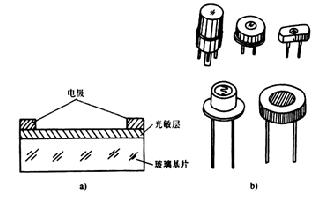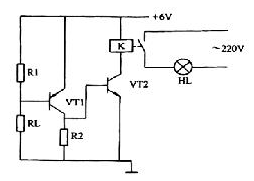In circuits, a photoresistor is represented by the letters "R," "RL," or "RG." Figure 1-25 shows its circuit symbol.

(I) Structure, Characteristics, and Applications of Photoresistors
1. Structure and Characteristics of Photoresistors: A photoresistor typically consists of a photosensitive layer, a glass substrate (or a resin moisture-proof film), and electrodes, as shown in Figure 1-26.

A photoresistor is a special type of resistor made using the photoconductive effect of semiconductors and is extremely sensitive to light. In the absence of light, it exhibits a high resistance; when exposed to light, its resistance decreases rapidly.
2. Applications of Photoresistors: Photoresistors are widely used in various automatic control circuits (such as automatic lighting control circuits and automatic alarm circuits), household appliances (such as automatic brightness adjustment in televisions and automatic exposure control in cameras), and various measuring instruments.
Figure 1-27 shows a photoresistor application circuit.

(II) Types of Photoresistors
Photoresistors can be classified based on their manufacturing materials and spectral characteristics.
1. Classification by Material
Photoresistors can be classified into polycrystalline and single-crystal types based on their manufacturing materials. They can also be divided into cadmium sulfide (CdS) photoresistors, cadmium selenide (CdSe) photoresistors, lead sulfide (PbS) photoresistors, lead selenide (PbSe) photoresistors, and indium antimonide (InSb) photoresistors, among other types.
2. Classification by Spectral Characteristics
Photoresistors can be classified into visible light photoresistors, ultraviolet light photoresistors, and infrared light photoresistors based on their spectral characteristics.
Visible light photoresistors are primarily used in various electronic products, such as photoelectric automatic control systems, electronic cameras, and light alarms.
Ultraviolet light photoresistors are primarily used in ultraviolet detection instruments. Infrared photoresistors are primarily used in automatic control systems in fields such as astronomy and military.
(III) Main Parameters of Photoresistors
The main parameters of photoresistors include light resistance (RL), dark resistance (RD), maximum operating voltage (VM), light current (IL), dark current (ID), time constant, temperature coefficient sensitivity, etc.
1. Light Resistance: Light resistance refers to the resistance value of a photoresistor when exposed to light.
2. Dark Resistance: Dark resistance refers to the resistance value of a photoresistor when it is not exposed to light (in a dark environment).
3. Maximum Operating Voltage: The maximum operating voltage refers to the maximum voltage a photoresistor can withstand at rated power.
4. Light Current: Apparent current refers to the current flowing through a photoresistor when it is exposed to light at a specified applied voltage and is not exposed to light.
5. Dark Current: Dark current refers to the current flowing through a photoresistor when it is not exposed to light and is exposed to a specified applied voltage.
6. Time Constant: The time constant is the time it takes for a photoresistor to reach 63% of its stable current after the initial light transition.
7. Temperature Coefficient of Resistance: The temperature coefficient is the relative change in resistance when the ambient temperature changes by 1°C.
8. Sensitivity: Sensitivity is the relative change in resistance when the photoresistor is exposed to light and when it is not.







 BR 10324
BR 10324  US 6578
US 6578  MY 2435
MY 2435  VN 2327
VN 2327  MX 1508
MX 1508  CN 1499
CN 1499  IN 1185
IN 1185  AR 964
AR 964 




